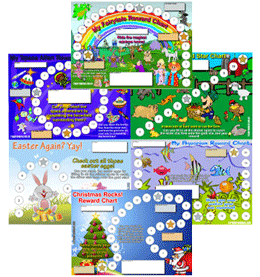The general strategy for using a kids reward chart is to award a sticker to be placed on the chart when your child has displayed a desired behavior, completed a certain task or chore, or when your instructions have been followed.
For example you might have an agreement with your child that are awarded a sticker when their dirty clothes go in the wash basket rather than on the floor, or it may be that they earn a sticker when they use their manners at the dinner table and ask to be excused when they’ve finished their meal.
And so it goes until they have achieved a full chart of stickers. That’s the typical milestone or goal of a kids reward chart. However, an alternative approach using the same reward chart can also prove to be particularly effective.
Now before we get into this, I must restate (as I have in other areas of this website) that using a kids reward chart is generally considered to be a tool for positive reinforcement. So with this in mind my aim as a parent would be to shower attention on the desired behaviors and ignore the unwanted behaviors. It may be that a child receives a sticker for using a “quiet” voice for resolving an argument, and their attempt at resolving an argument by yelling is completely ignored. In time, a child will grasp the concept that yelling won’t work to achieve the outcome that they want.
Kids Reward Chart: Alternative Steps To Take
This process works fantastically well with kids reward charts, and if it’s working well with your child, or if it fits well with your parenting philosophies…Great! Continue using this approach. However, for those parents who want to change things up a little, or who want to add a different “twist” to the reward chart concept, then this approach to using a kids chart might be worth considering.
- As with any reward chart, establish with your children, the target behaviors and aims of the chart.
- Set up a time limit that the kids reward chart will last, such as a day, a week etc.
- Establish different reward values for the number of stickers. For example a full kids chart of stickers would gain the maximum reward value, a half full chart would equate to
a half reward, and obviously an empty reward chart would mean no reward given.
- Start the reward chart challenge by filling the kids reward chart with the reward stickers. When your child reneges on the reward chart agreement, then simply remove one of the stickers.
- Continue with this pattern for the duration of the reward chart time-limit, and then reward your child according to the number of stickers left on the chart. (Lots of stickers remaining…good, not many or no stickers remaining…not so good!)
- As an example, if we are considering a 10 sticker reward chart, then retaining all 10 stickers might earn a DVD night, and each sticker lost might earn a corresponding lesser reward. This ensures that it is still a positive experience for your child rather than a demoralizing one.
- If you choose to try out this alternative approach to using a kids reward chart, continue to take on the role of encouraging your child. A conversation might go something like this, “you’ve lost a sticker but I can see you’re trying hard. You’ve still got xx number of stickers, and we can try another chart tomorrow/next week.”
As you can see this approach relies not on the principle of earning stickers to achieve a desired reward, but rather on having the end reward in their grasp, and retaining or losing the reward based on how they choose to behave. In many ways this approach to using a reward chart is more based on the principles related to a child learning about “consequences”…Behave well, reap the rewards. Choose to behave badly, suffer the consequences. (This of course is a very simple illustration. In practice there are many dynamics involved in the lesson of “consequences”)
Using a reward chart in this way is better suited to an older child (early to mid school-aged) rather than a toddler. A toddler is less developmentally able to understand the underlying concepts.
It should also be remembered that using a kids reward chart in this manner should be achievable, motivational, and should still be a positive experience for your kids. Taking stickers away from children should never be about beating them down. Rather it should be about your child learning to control their behavior, choose appropriate behaviors, and stick to their agreements, all within a positive parenting framework.
Note: Our Rewarding Kids Token Economy System uses these principles very effectively.

